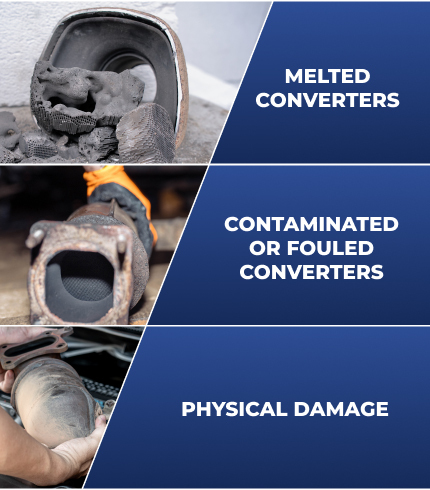Catalytic Converter Failure
The catalytic converter is designed to last the lifetime of the vehicle. It relies on receiving the proper mix of exhaust gasses from the engine at the proper temperature. Anything that seriously affects the mix and temperature of the exhaust gas will affect the effectiveness of the converter and may ruin it. Follow the guideline set out below to ensure your customer gets the maximum life out of the new replacement catalytic converter.

IDENTIFY
Catalytic converters play a crucial role in reducing harmful emissions from your vehicle’s exhaust. They are designed to last the lifetime of the vehicle. However, they can fail over time due to various reasons.
MELTED CONVERTERS
The catalytic converter relies on receiving the proper mix of exhaust gasses from the engine at the proper temperature. The catalytic converter continues to burn (oxidise) any unburnt or partially burnt fuel in the exhaust gas. Excessive unburnt or partially burnt fuel in the exhaust gas will result in elevated temperatures and may melt the internal converter structure.
Symptoms
- The metal body of the catalytic converter will be purple or brown, a clear sign of overheating
- Rattling sound, like glass balls in a metal container, coming from the engine bay or from under the vehicle
- Smokey or noxious smelling tail pipe emissions
- Poor engine performance
- Illuminated engine check lamp
Causes of Overheating
The following will seriously affect the mix and temperature of the exhaust gas. If left un-addressed the catalytic converter will melt or fail and will require replacement.
- Engine Misfires
- A rich air-fuel mixture
- Overloading the vehicle or trailer
- Leaking fuel injectors
- Worn valve seats
- Low compression
- Poor spark or no spark
- Air fuel ratio cylinder imbalance
- Poor fuel quality
- Poor quality or defective O2 sensors
- Excessive exhaust backpressure
- Age and wear. Over time, the ceramic structure inside can begin to break down
CONTAMINATED OR FOULED CONVERTERS
The catalytic converter will only work if the exhaust gas passing through it is exposed to the catalyst particles on its internal honeycomb structure. If the honeycomb structure is coated in contaminants, carbon or oil the catalytic converter will not work as designed.
Symptoms
- Smoky or smelly tail pipe emissions
- Poor engine performance
- Illuminated engine check lamp
Causes of Contamination and Fouling
- Excessive Oil Consumption (oil leaks)
- Poor quality fuel
- Incompatible fuel and oil additives
- Excessive carbon buildup in exhaust
- Use of incompatible gasket sealants
PHYSICAL DAMAGE
The stainless steel construction of the “hot end” exhaust system and the internal thin walled honeycomb ceramic structure of the catalytic converter can degrade or fracture.
Symptoms
- Rattling sound of a loose exhaust system
- Rattling sound, like glass balls in a metal container, coming from the engine bay or from under the car
- Whistling sound coming from the engine bay or from under the vehicle
- Exhaust smoke coming from the engine bay or from under the vehicle
- Smoky or noxious smelling tail pipe emissions
- Illuminated engine check lamp
Causes of physical damage
- Rust and Corrosion - Exposure to environmental factors can lead to deterioration of the steel and stainless steel parts of the catalytic converter system
- Thermal shock - Rapid cooling or heating stress the catalytic converter which can lead to cracking
- Metal fatigue/stress fractures - Excessive vibrations, stressed sections and thermal shock can lead to fatigue cracking
- Cracked flex section -Excessive vibrations or stress can cause the very thin material in the flex section to crack
- Impact damage - Physical hits to the road and debris can dent and dislodge the catalytic converter
CATALYTIC CONVERTER PROTECTION
By incorporating these practices into your vehicle care routine, you can significantly reduce the chances of catalytic converter failure.
Regular Maintenance
Follow the manufacturer’s maintenance schedule for your vehicle.
Quality Fuel
Use high-quality, clean fuel to reduce the risk of contamination.
Prompt Repairs
Address engine issues, leaks, or warning lights promptly.
Exceeds Industry Standards
Refrain from using additives containing manganese or lead.
Proper Driving Habits
Avoid aggressive driving and minimize idling to reduce stress on the converter.
Cooling System Checks
Ensure the engine cooling system is in good condition to prevent overheating.
Careful Off-Road Driving
If driving off-road, be cautious to avoid physical damage to the converter.
Choose Low-Sulphur Fuels
Opt for fuels with low sulphur content to minimize stress on the catalyst.
Regular Inspections
Periodically inspect the exhaust system for signs of damage or rust.
Use of Heat Shields
Ensure proper installation and functioning of heat shields.
Proper Engine Tuning
Keep the engine properly tuned to maintain the correct air-fuel ratio.
Correct Installation
Ensure the catalytic converter is correctly installed to prevent leaks or misalignment.
Avoid Overloading & Excessive Towing
Stay within the vehicle’s load and towing capacity.
Replace Faulty Oxygen Sensors
Promptly replace any malfunctioning oxygen sensors.
Proper Warm-Up
Allow the engine to warm up before driving, especially in cold conditions.
Follow the Manufacturer Guidelines
Adhere to the manufacturer’s recommendations and guidelines for your specific vehicle.
Avoid Aftermarket Modifications without Proper Tuning
If modifying the vehicle, ensure proper tuning to avoid stress on the converter.
The content provided on this web page is intended for informational purposes only. It does not constitute professional advice or services. Any reliance on the content is at your own risk. The website owner and contributors shall not be liable for any errors or omissions in the content or for any actions taken based on the information provided. We strongly recommend consulting a car mechanic or technician if you believe your catalytic converter needs replacing.

